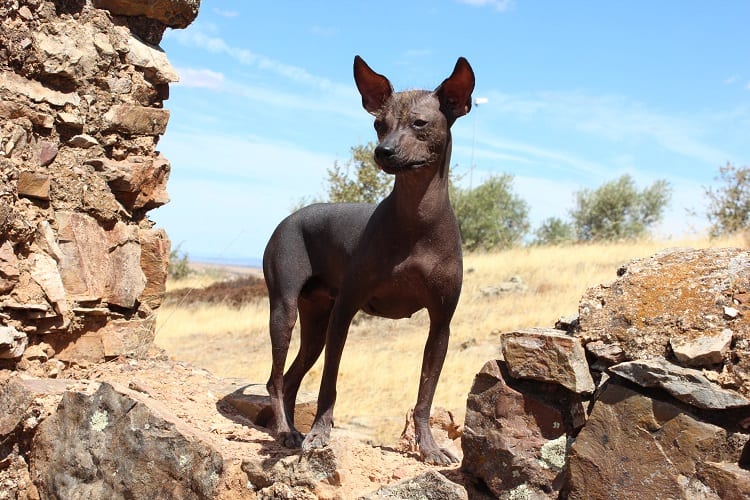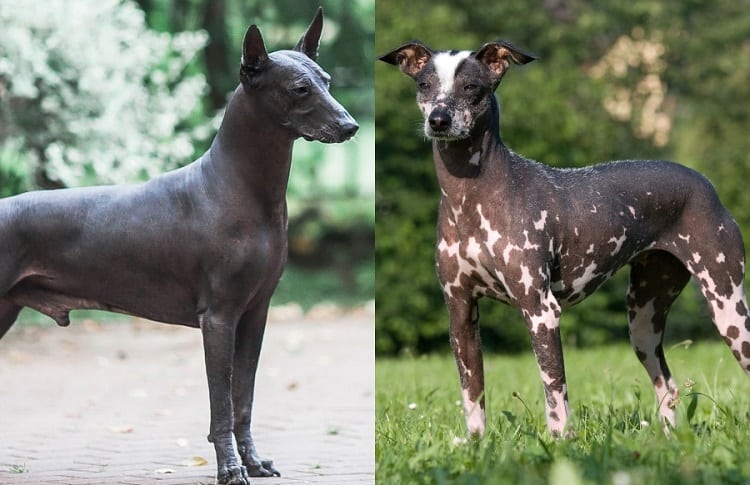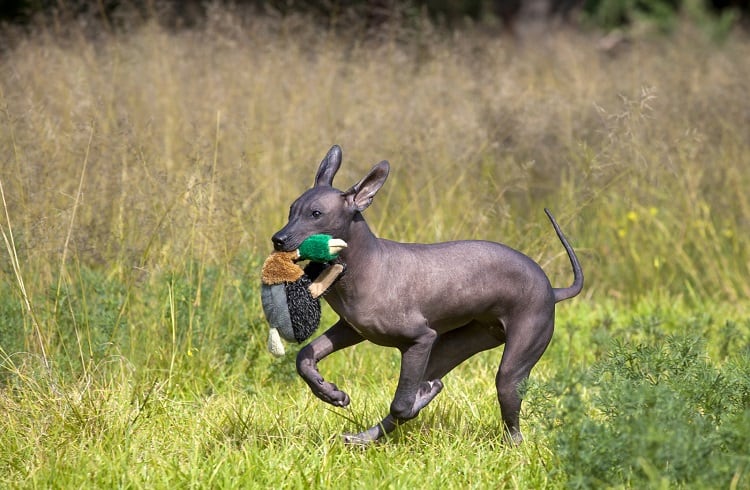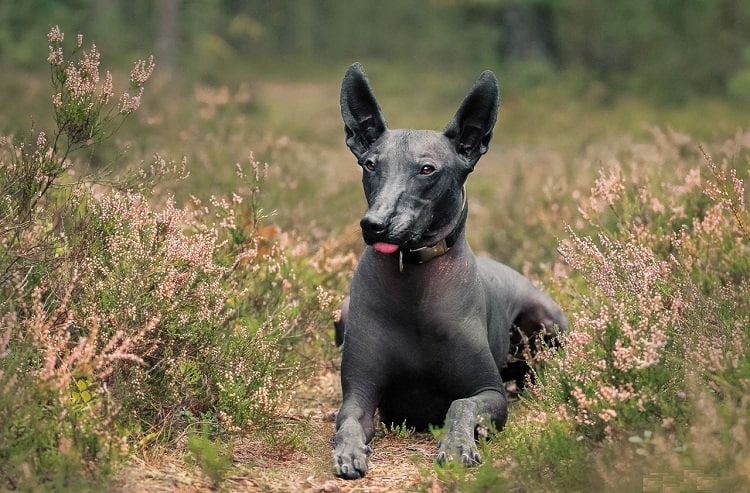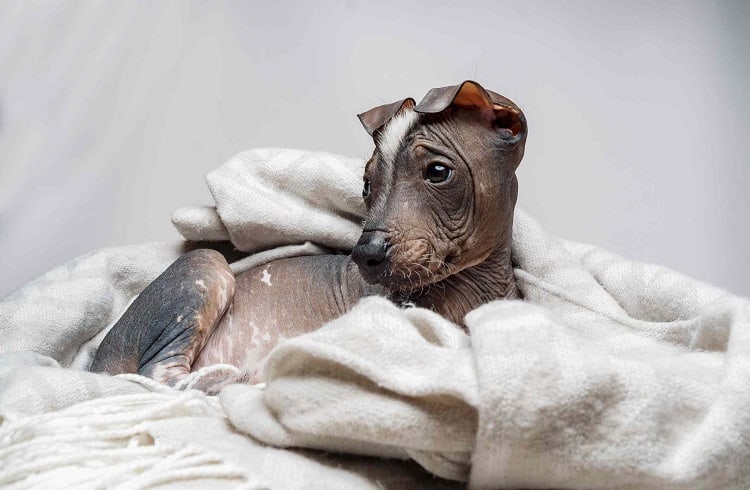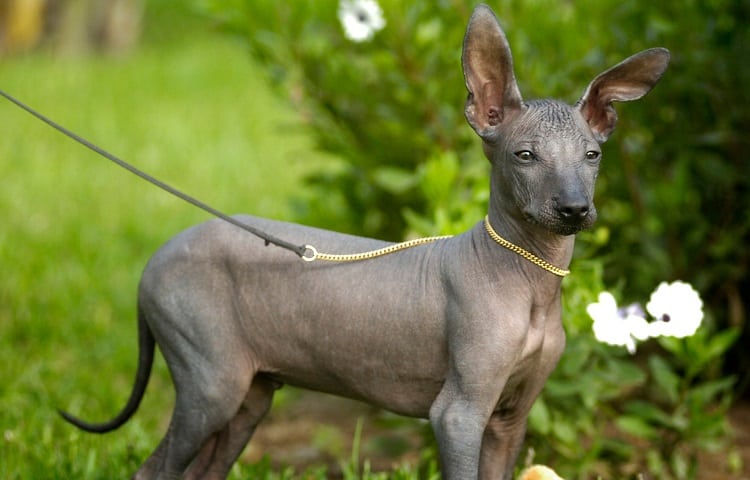Peruvian Inca Orchid Breed History
The Peruvian Inca Orchid (also known as the Peruvian hairless dog) has quite the long and eventful history, as it may actually be one of the earliest dog breeds to have been domesticated by humans.
There are artifacts and relics that date all the way back to 750 A.D, that have clearly been dedicated to the breed. These items, often pottery, were created by the Incas, Chancay and Chimu empires, which were all based in the country of Peru.
The Peruvian Inca Orchid is not your typical looking dog, as they are almost completely hairless, minus the odd tuft of hair that appears on their heads.
This breed was recognized among ancient Peruvian tribes as an incredibly loyal companion and friend, and was also seen as a potential provider of healing properties.
Among the ancient Chimu people of Peru, the urine and feces of Peruvian Inca Orchids was actually used in a number of medicines.
The dogs themselves were believed to promote good health, and were even used to help treat conditions like arthritis and other structural health issues.
Originally, Peruvian Inca Orchids were a relatively small breed of dog. However, after the Spanish had conquered Peru, they began to breed these small dogs with their own larger breeds, which created the size range that we see today.
The Peruvian Inca Orchid wasn’t always praised the way they were in ancient times.
Throughout certain urban areas, they were often seen as diseased and sickly dogs, mainly because of their lack of hair and exposed wrinkly skin.
However, there were many that did have affection for the breed, especially an American man named Jack Walklin.
In 1966 Jack decided to bring eight Peruvian Inca Orchid’s back to his home with him after a visit to Peru.
He is part credited with the name as well as the eventual growth and popularity of the breed throughout North America and Europe in the late 20th century.
In 2001 the Peruvian government officially declared the Peruvian Inca Orchid a National Patrimony, and the breed is now fully protected in its home country.
Xoloitzcuintli Breed History
The Xoloitzcuintli is another breed of dog that has quite a colorful history and interesting origin story.
This breed was bred and owned by ancient Aztec and Mayan communities as a companion, a healing presence, an occasional food source, and most interestingly, a guide to the Underworld.
The name Xoloitzcuintli was created through the use of two words in the Aztec language. “Xolotl”, which refers to\ the god of lightning and death, as well as the word “itzcuintli”, which means dog.
According to the beliefs of the Aztec people, this dog was created by Xolotl in order to guard the living, and guide the souls of the dead safely to the Underworld.
This breed was considered to be sacred, and were often sacrificed and buried with their deceased owners, as they would be able to help guide their owner’s souls to the land of the dead.
As one of the most ancient dog breeds recorded in the Americas, researchers have drawn conclusions that indicate the ancestors of the xoloitzcuintli actually accompanied the earliest Asian migrants, and slowly developed, over the past 3500 plus years, into the breed we see today.
The arrival of European conquerors essentially forced the breed to the cusp of extinction, thanks to their desire to use dog meat as a source of energy.
By the early 19th century these dogs could only be found in remote villages that were relatively unaffected by colonizers.
The Xoloitzcuintli was actually one of the earliest dog breeds to be accepted by the American Kennel Club, back in 1887. However, its numbers didn’t grow over time.
In the1950s, a team of canine experts determined to revive the breed, launched an expedition to the remote Mexican countryside in order to find and acquire surviving dogs.
Of the dogs that were found, ten were able to be identified as being of Xoloitzcuintli descent. These dogs ended up being the foundation for the revival of their breed.
In the year 2011, the Xoloitzcuintli dog breed was formally recognized by the AKC.
Today, these dogs are praised for their unconventional appearance and pedigree as an incredibly interesting ancient cultural icon.
The official national dog of Mexico has been receiving international recognition in more recent times as well, having been featured in the popular Pixar movie “Coco”.
Peruvian Inca Orchid Vs. Xoloitzcuintli
Size & Weight
Height
Peruvian Inca Orchid
- Small: 10in to 16in (25cm to 40cm)
- Medium: 16in to 20in (40cm to 50cm)
- Large: 20in to 26in (50cm to 65cm)
Xoloitzcuintli
- Toy: 10in to 14in (25cm to 36
- Miniature: 14in to 18in (36cm to 46cm)
- Standard: 18in to 23in (46cm to 58cm)
Weight
Peruvian Inca Orchid
- Small: 9lbs to 18lbs (4kg to 8kg)
- Medium: 18lbs to 26lbs (8kg to 12kg)
- Large: 26lbs to 55lbs (12kg to 25kg)
Xoloitzcuintli
- Toy: 10lbs to 15lbs (4.5kg to 7kg)
- Miniature: 15lbs to 30lbs (7kg to 13.5kg)
- Standard: 30lbs to 55lbs (13.5kg to 25kg)
Temperament
Peruvian Inca Orchid
These dogs are known for being very loving, loyal, and protective of their family and other people of significance. They are incredibly alert and aware of their surroundings, which makes them great protectors and warning signals.
The Peruvian Inca Orchids are emotionally intelligent and sensitive and will seek affection from their people. They are known for being very noble and also quite territorial inherently.
When it comes to strangers or other unknown presences, the Peruvian Inca Orchid can be quite nervous or wary, and will usually need time to adjust and build trust with new people.
This breed is also inherently quite prey-driven, and will take off in pursuit of anything that is small moving fast, so it is important to keep them leashed when necessary!
Xoloitzcuintli
The Xoloitzcuintli is quite similar in temperament to the also hairless Peruvian Inca Orchid.
They are a breed that is calm but always alert, very intelligent, and highly devoted to their family and loved ones.
These dogs are known for being affectionate companions who can even become somewhat needy when they are not being recognized by their people.
The Xoloitzcuintli is a breed that is somewhat standoffish by nature, and will often act aloof around strangers.
These dogs should be properly socialized from an early age in order to expose them to different people and other dogs, and avoid problematic situations as they grow older.
Similar to the Peruvian Inca Orchid, this breed is inherently prey-driven, and will be inclined to chase small, fast-moving animals out of instinct. They should be leashed when necessary!
Coat & Shedding
The Peruvian Inca Orchid and Xoloitzcuitnli have very similar coats and shedding tendencies (or lack thereof). Both of these dog breeds can be either hairless or coated.
The ones that are hairless are known to have small tufts on their head, feet and tail in some cases.
The ones that do have coats have a very short thin coat all over their bodies. These short coats differ slightly between the two different breeds.
In terms of shedding, both of these breeds are either hairless or have a very short and thin coat that will produce little to shedding.
These dogs are hypoallergenic, virtually dander free, and do not need very much in regards to coat maintenance. They can be found in a variety of colors including black, tan, gray, white and bronze.
Health Issues
Xoloitzcuintli
This breed has been through centuries of natural selection and built a strong genetic structure, and as a result do not have any breed-specific diseases or issues.
As with all large dog breeds, they can be prone to hip and elbow dysplasia and need to have their ears and teeth properly.
The Xoloitzcuintli is a breed that typically has a lot of exposed skin, even on dogs who are considered “coated”. As a result, they can be susceptible to dry skin, rashes, and other skin infections or irritations.
Their exposed skin also makes them fairly susceptible to sunburns and should be protected accordingly.
Peruvian Inca Orchid
The Peruvian Inca Orchid is also a breed that has been around for centuries, and as a result is not genetically predisposed to any diseases, illnesses or other health issues.
These dogs can experience hip and elbow problems, and can also suffer from epilepsy and pancreatic inflammation.
Like virtually all hairless dog breeds, the Peruvian Inca Orchid is known for being extra prone to cuts, bruises and skin irritations or a variety of skin conditions.
They should be monitored to ensure that their skin remains healthy, and should be properly covered when in the direct sun to avoid sunburns.
Peruvian Inca Orchid Vs. Xoloitzcuintli: Who Is The Better House Dog?
When it comes down to the question of which breed is the better house dog, it is not really possible to provide a definitive answer, as these dogs are very similar and will have the same characteristics as a house dog.
Both of these breeds are incredibly intelligent and will be easy to train which is an important attribute of a good house dog. They are not known to be very vocal, and will not often bark unless provoked.
Thanks to the fact that they are hairless for the most part, these dogs do not require much in terms of grooming and cleaning, and they will not produce much in terms of shedding and/or odors.
However, their exposed skin does need to be properly monitored in order to prevent any skin issues.
Both the Peruvian Inca Orchid and the Xoloitzcuintli have the potential to be great house dogs, if trained and cared for properly.
They are intelligent, very affectionate, and will be incredibly devoted to their family.
They are low-maintenance and you do not have to worry about excessive noise or shedding or bad odor.
Their unconventional appearance is almost endearing, and these culturally iconic dogs could both make great house dogs.

Dan is a well respected content researcher who has vast experience working projects in the pets niche. He is a frequent contributor to dogtemperament.com and loves delivering numerous helpful dog articles like this one that are read by thousands of our readers monthly.
